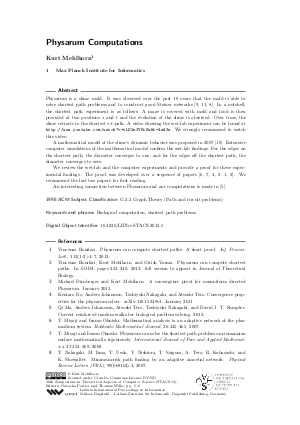Physarum Computations (Invited Talk)
Author Kurt Mehlhorn
-
Part of:
Volume:
30th International Symposium on Theoretical Aspects of Computer Science (STACS 2013)
Part of: Series: Leibniz International Proceedings in Informatics (LIPIcs)
Part of: Conference: Symposium on Theoretical Aspects of Computer Science (STACS) - License:
 Creative Commons Attribution-NoDerivs 3.0 Unported license
Creative Commons Attribution-NoDerivs 3.0 Unported license
- Publication Date: 2013-02-26
File

PDF
LIPIcs.STACS.2013.5.pdf
- Filesize: 363 kB
- 2 pages
Document Identifiers
Subject Classification
Keywords
- Biological computation
- shortest path problems
Metrics
- Access Statistics
-
Total Accesses (updated on a weekly basis)
0PDF Downloads0Metadata Views
Abstract
Physarum is a slime mold. It was observed over the past 10 years that the mold is able to solve shortest path problems and to construct good Steiner networks [9, 11, 8].In a nutshell, the shortest path experiment is as follows: A maze is covered with mold and food is then provided at two positions s and t and the evolution of the slime is observed. Over time, the slime retracts to the shortest s-t-path. A video showing the wet-lab experiment can be found at http://www.youtube.com/watch?v=tLO2n3YMcXw&t=4m43s. We strongly recommend to watch this video. A mathematical model of the slime's dynamic behavior was proposed in 2007 [10]. Extensive computer simulations of the mathematical model confirm the wet-lab findings. For the edges on the shortest path, the diameter converges to one, and for the edges off the shortest path, the diameter converges to zero. We review the wet-lab and the computer experiments and provide a proof for these experimental findings. The proof was developed over a sequence of papers [6, 7, 4, 2, 1, 3]. We recommend the last two papers for first reading. An interesting connection between Physarum and ant computations is made in [5].
Cite As Get BibTex
Kurt Mehlhorn. Physarum Computations (Invited Talk). In 30th International Symposium on Theoretical Aspects of Computer Science (STACS 2013). Leibniz International Proceedings in Informatics (LIPIcs), Volume 20, pp. 5-6, Schloss Dagstuhl – Leibniz-Zentrum für Informatik (2013)
https://doi.org/10.4230/LIPIcs.STACS.2013.5
BibTex
@InProceedings{mehlhorn:LIPIcs.STACS.2013.5,
author = {Mehlhorn, Kurt},
title = {{Physarum Computations}},
booktitle = {30th International Symposium on Theoretical Aspects of Computer Science (STACS 2013)},
pages = {5--6},
series = {Leibniz International Proceedings in Informatics (LIPIcs)},
ISBN = {978-3-939897-50-7},
ISSN = {1868-8969},
year = {2013},
volume = {20},
editor = {Portier, Natacha and Wilke, Thomas},
publisher = {Schloss Dagstuhl -- Leibniz-Zentrum f{\"u}r Informatik},
address = {Dagstuhl, Germany},
URL = {https://drops.dagstuhl.de/entities/document/10.4230/LIPIcs.STACS.2013.5},
URN = {urn:nbn:de:0030-drops-39166},
doi = {10.4230/LIPIcs.STACS.2013.5},
annote = {Keywords: Biological computation, shortest path problems}
}
